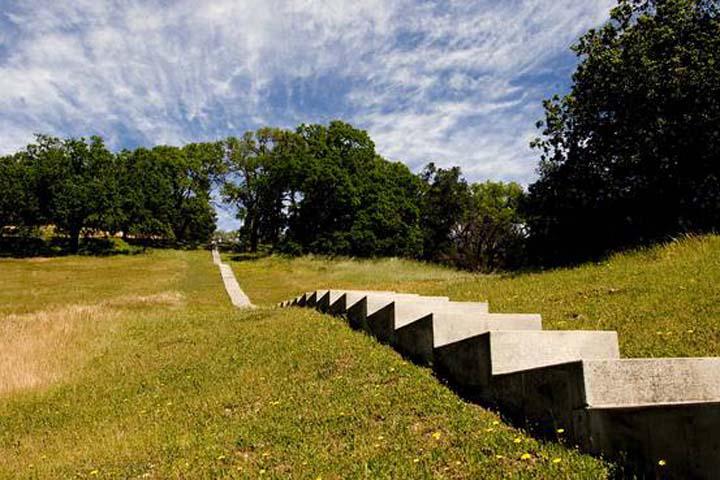Art Destinations 101
With art lovers hungry for actual experiences and cautiously ready to make plans, it can seem that there are too many possibilities for so little time. Whether you’re a serious art nerd who languishes without frequent interventions, or a casual museum goer who enjoys the occasional culture dip, there is a guide for you: 101 Art Destinations in the US: Where Art Lives Coast to Coast by Owen Phillips (Rizzoli Electa 2018). Above: Glenstone Museum, sculpture by © Felix Gonzales-Torres; photo: Jerry Thompson
The book includes the obvious big-city mega hits like The Met, SF MOMA, and the Art Institute of Chicago. It incudes private museums like The Broad and the Glenstone Museum. It includes the best-known Land Art installations such as Robert Smithson’s Spiral Jetty and the more under-sung, like Nancy Holt’s Sun Tunnels. It also includes some of the most out-of-the-way or hard-to-get-to sites like Michael Heizer’s Double Negative.
What comes through in the text—and the book is primarily text—is the author’s highly informed and highly personal takes on why you should go and what to seek out. Phillips writes with engaging authority on every subject that a great art destination embraces: art in every medium; architecture, both classical and contemporary; landscape, designed and wild; lighting, designed and natural; and the experience that awaits you. Following are some examples of his highly engaging views.

“The Metropolitan Museum of Art is the obvious first stop for anyone embarking on an art tour of the United States. It manages to not feel like one of the biggest, most visited museums in the world….The sense of being able to wander, stumbling upon new or forgotten treasures as you head toward what you think you came to see is why the magic works.”
“The home and studio where Jackson Pollock and Lee Krasner lived and worked is simply the most vital historical artist studio that can be visited today….But the studio—an uninsulated shack—is what really gets the adrenalin going. On the floor are Pollock’s splatters—he developed his all-over splatter style here,…[Krasner] made her most important paintings [there] after his death. Paint cans and knives and brushes used by both artists are here and look ready to be picked up and put to use again any moment.” Above: photo coutesy Pollack Krasner Foundation
About [N.C., Andrew and Jamie] Wyeth Studios, Phillips writes, “The art historian Robert Rosenblum tagged [Andrew] as the most overrated and underrated American artist, but he’s in most major museum collections one way or another (and since he was frequently mentioned in Charles Schultz’s Peanuts comic strip, he can’t be all bad.)”
About the Nasher Sculpture Center: “There are not many museums where sculpture is boss….The collection became so famous everyone wanted it—the Tate, the Guggenheim and more—but the real-estate developer and mall king and his wife got Renzo Piano to build a little masterpiece for it in their hometown of Dallas….the building is entirely glass at the front and back. You can see straight through it from the street to the garden, and it’s perfect for sculpture and the kinds of thoughtful shows the Nasher curators put on, which always factor in the space between objects.”
About Nancy Holt’s Sun Tunnels: “Land Art was often described as utilizing a “bigger canvas,” and many of the artists compared what they were doing to drawing on the earth. The site of Sun Tunnels is 83 feet across (on a 40-acre plot of land Holt bought in 1973), but with its reach to snow-covered mountains on all sides, it’s truly hundreds of miles wide. In fact, by boring holes in each tunnel that shine light forming the constellations…she has brought astronomy into the piece—and was the first Land artist to do so.” Above: Robert Smithson, Spiral Jetty, 1970. © Holt/Smithson Foundation and Dia Art Foundation/Licensed by VAGA at Artists Rights Society (ARS), NY. Photo: George Steinmetz
About David Ireland House/500 Capp Street Foundation: “He was called “the most influential conceptual artist you’ve never heard of” by Jock Reynolds, formerly of the Yale University Art Gallery, and his work can be partly understood as one part Arte Povera (with its urge to make everyday objects meaningful) and one part Fluxus (with its disregard for boundaries between the arts, and disdain for the creation of artistic product)….The walls are key to Capp Street…the sheen captures surprising reflections as a visitor moves around the house, and Ireland’s interventions in the architecture of the space frame unexpected vistas or direct attention where he wants it.”
In addition to the pithy, synoptic texts, Phillips also has created “Suggested Itineraries” for tours within each geographic region, from weekend escapes to full-on vacations. The book was launched before COVID19 so some of the info is understandably out of date; it’s easy enough to verify, which you would do anyway before heading out.
101 Art Destinations in the the US: Where Art Lives Coast to Coast by Owen Phillips (Rizzoli Electa 2018) Info
Owen Phillips is an Los Angeles-based writer and editor. He wrote and art directed for The New Yorker magazine for fifteen years, where among other things he commissioned a long-running series of self-portraits by major artists. He has led magazine launches and redesigns (including Men's Vogue, the Wall Street Journal's WSJ magazine, and The Hollywood Reporter). In addition to writing about art, food, architecture, and design, he is an editorial consultant and content strategist for a variety of media and tech companies.





